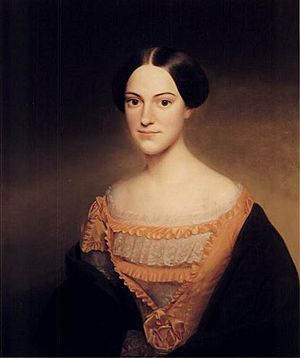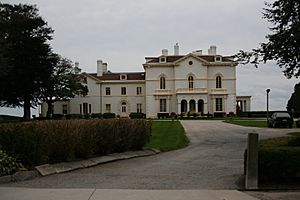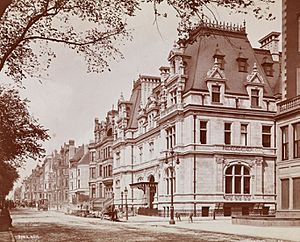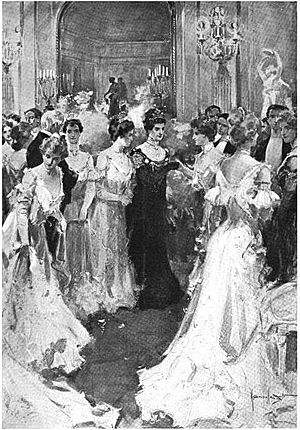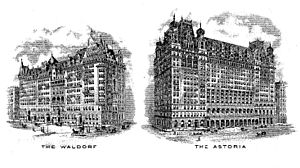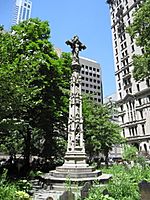Caroline Schermerhorn Astor facts for kids
Quick facts for kids
Caroline Schermerhorn Astor
|
|
|---|---|
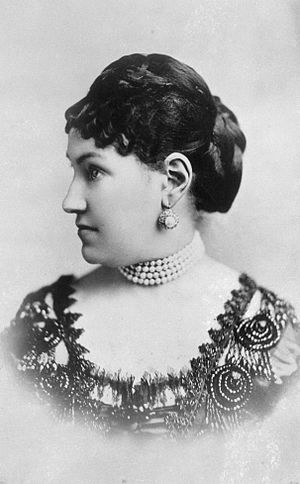
Photograph of Astor, c. 1853-1860
|
|
| Born |
Caroline Webster Schermerhorn
September 22, 1830 New York City, U.S.
|
| Died | October 30, 1908 (aged 78) New York City, U.S.
|
| Resting place | Trinity Church Cemetery |
| Known for | self-proclaimed The Mrs. Astor, matriarch of male line of American Astors |
| Spouse(s) |
William Backhouse Astor Jr.
(m. 1853; |
| Children | 5 |
| Parent(s) | Abraham Schermerhorn Helen Van Courtlandt White |
| Relatives | See Astor family |
Caroline Webster "Lina" Schermerhorn Astor (born September 22, 1830 – died October 30, 1908) was a very important American socialite. She was famous in the late 1800s. People often called her "the Mrs. Astor" because she was so well-known. She was married to William Backhouse Astor Jr., a businessman and owner of racehorses. Lina was the mother of five children. Her son, John Jacob Astor IV, sadly died on the Titanic. Through her marriage, she became a leading member of the powerful Astor family.
Contents
Early Life of Caroline Astor
Lina was born on September 22, 1830. Her family was very wealthy and part of New York City's old Dutch families. They were descendants of the city's first settlers. Her father, Abraham Schermerhorn, was involved in shipping.
Lina was the ninth child of Abraham and Helen Van Courtlandt Schermerhorn. Her older sister, Elizabeth, married General James I. Jones. He owned a large farm in upper Manhattan.
When Lina was born, her family lived at 1 Greenwich Street. As New York City grew, they moved north to 36 Bond Street. This area was very fashionable. It was near "Lafayette Place," which was developed by her future husband's grandfather, John Jacob Astor.
Young Lina went to a school run by Mrs. Bensee. She was a French teacher. Lina learned to speak French very well there.
Marriage and Family Life
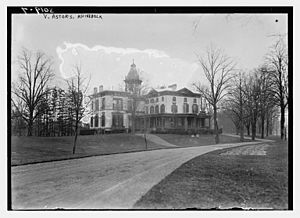
On September 23, 1853, Lina married William Backhouse Astor Jr.. Their wedding was at Trinity Church. Her husband was the middle son of William Backhouse Astor Sr.. His grandfather was the famous John Jacob Astor.
The Astor family made their money from the fur trade. Later, they invested in New York City real estate. Even though the Astors were rich, Lina's family had an older, more respected background. They were part of the "Knickerbocker" families. These were the original Dutch settlers of Manhattan from the 1600s.
Lina and William had five children:
- Emily Astor (1854–1881). She married James J. Van Alen. They had three children.
- Helen Schermerhorn Astor (1855–1893). She married James Roosevelt Roosevelt. He was the half-brother of future President Franklin D. Roosevelt. They had two children.
- Charlotte Augusta Astor (1858–1920). She married J. Coleman Drayton and later George Ogilvy Haig. She had four children with Mr. Drayton.
- Caroline Schermerhorn "Carrie" Astor (1861–1948). She married Marshall Orme Wilson in 1884. They had two sons.
- John Jacob "Jack" Astor IV (1864–1912). He married Ava Lowle Willing and had two children. Later, he married Madeleine Talmage Force. He died on the Titanic. His son was born after his death.
Caroline Astor as a Socialite
For many years, Lina Astor focused on raising her five children. She also managed her household. This was common for women of her social class in New York City. Lina had her own money from her parents. This made her less dependent on her husband.
In 1862, Lina and her husband built a large townhouse. It was at 350 Fifth Avenue. This is where the Empire State Building stands today. Their home was next door to her husband's older brother. The two families lived side-by-side for 28 years.
The Astors also had a grand summer home. It was in Newport, Rhode Island. This home was called Beechwood. It had a ballroom big enough for "The 400." These were the most fashionable people of the time.
The Gatekeeper of Society
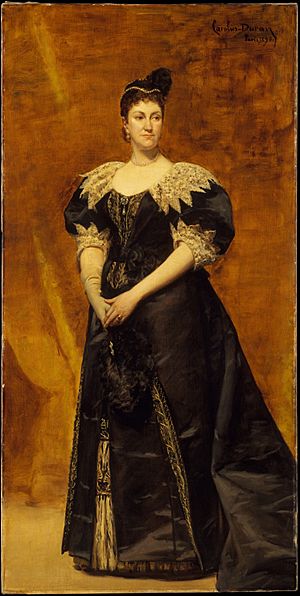
After the Civil War, New York City grew very fast. Many new wealthy people moved to the city. They challenged the old New York families. Lina Astor, with help from Ward McAllister, tried to set the rules for proper behavior. They decided who was allowed into the most exclusive social circles. They were champions of "old money" and tradition.
McAllister once said that only 400 people truly belonged to "Fashionable Society." This number was not based on the size of Mrs. Astor's ballroom. Her husband was not interested in social events. This allowed Lina to focus even more on her social activities. Her influence grew as her children got older.
Lina was the top authority on New York's "Aristocracy." She hosted grand and fancy parties. No one could attend without an official invitation from her. Her social groups were led by strong-willed, "aristocratic" women. These gatherings showed off great luxury and were often talked about. The group itself was seen as the very top of New York's elite. Lina and her friends represented "Old Money."
Relationship with the Vanderbilts
The Vanderbilt family had made a huge fortune. But they earned their money, they did not inherit it from old family lines. This "new money" was not liked by Astor and her group. Mrs. Astor found wealth from railroads to be less proper. Because of this, Astor did not want to invite the Vanderbilt women into her circle.
However, in 1883, Astor had to accept Alva Erskine Smith. Alva was the first wife of William Kissam Vanderbilt. This acceptance allowed the Vanderbilts, who had the biggest "new" fortune, to enter the highest levels of society.
A famous New York story says that Alva Vanderbilt planned a big costume ball. She told Lina's youngest daughter, Caroline, that she could not join. This was because Mrs. Astor had never officially visited Alva. It is also likely that Astor saw the Vanderbilts' growing social power. She may have decided they would be useful allies. So, she formally visited the Vanderbilts before Alva's ball. Astor herself attended the ball. After this, the Vanderbilts were invited to Astor's yearly ball. This showed they were fully accepted into New York society.
The Title of "Mrs. Astor"
Until 1887, Lina Astor was known as "Mrs. William Astor." But when Charlotte Augusta Gibbes died that year, Lina became the oldest Mrs. Astor. So, she shortened her title to "Mrs. Astor."
Charlotte's son, William Waldorf Astor, felt his own wife should be "the Mrs. Astor." When his father died in 1890, William Waldorf Astor inherited his share of the Astor family's wealth. He became the official head of the Astor family. In his mind, this made his wife, Mamie, "The Mrs. Astor." However, Mamie was much younger than Lina. She did not have Lina's social power.
William Waldorf Astor tried to challenge Lina's top position in New York society. But he failed. Soon after, he moved with his family to England. There, he later became a viscount.
The Waldorf-Astoria Hotel
- Further information: Waldorf–Astoria (1893–1929)
To get back at his aunt, William Waldorf Astor tore down his father's house. He replaced it with the first Waldorf Hotel. The hotel was built to be much grander than Mrs. Astor's mansion next door. It was meant to show off his status. The Waldorf Hotel was thirteen stories tall. It was built like a German castle. It stood taller than all other buildings nearby. Mrs. Astor famously called it "a glorified tavern next door."
Before the Waldorf Hotel, polite society did not meet in public places. They especially avoided hotels. Mrs. Astor did not want to live next to this new, popular hotel. So, she and her son, Jack, decided to tear down their house. They built another hotel on its site, called the Astoria. Soon, the two hotels joined together. They became the original Waldorf-Astoria Hotel.
After this, Astor built a huge double mansion for herself and her son. Mrs. Astor lived in the northern part, at 841 Fifth Avenue. Her son lived in the southern half, at 840 Fifth Avenue.
The Astors' Fifth Avenue home and the Astoria Hotel were later torn down. This happened in 1927 and 1928. They made way for Temple Emanu-El and the Empire State Building.
Death
By the time she moved into her new house, her husband had died. She lived with her son and his family. In her last years, Astor suffered from memory problems. She died on October 30, 1908, at age 78. She was buried in the Trinity Church Cemetery in southern Manhattan.
Her youngest daughter, Carrie, built a tall monument for her. It is 39 feet (11.9 m) tall. This monument is in the churchyard cemetery. Many important early Americans are buried there.
After Mrs. Astor's death, it took three women to fill her important role in New York Society. These were Marion Graves Anthon Fish, Theresa Fair Oelrichs, and Alva Belmont.
See also
 In Spanish: Caroline Schermerhorn Astor para niños
In Spanish: Caroline Schermerhorn Astor para niños


